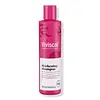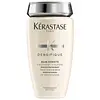What's inside
What's inside
 Key Ingredients
Key Ingredients

 Benefits
Benefits

 Concerns
Concerns

 Ingredients Side-by-side
Ingredients Side-by-side

Water
Skin ConditioningAmmonium Lauryl Sulfate
CleansingCocamidopropyl Betaine
CleansingCaprylyl/Capryl Glucoside
CleansingGlycerin
HumectantParfum
MaskingGlycol Distearate
EmollientSodium Benzoate
MaskingCitric Acid
BufferingLauryl Glucoside
CleansingLaureth-7 Citrate
CleansingLaureth-4
EmulsifyingPiroctone Olamine
PreservativePanthenol
Skin ConditioningPolyquaternium-10
Soluble Collagen
HumectantHydrolyzed Keratin
HumectantTrisodium Ethylenediamine Disuccinate
Chondrus Crispus Extract
Skin ConditioningFucus Vesiculosus Extract
EmollientLaminaria Digitata Extract
Skin ProtectingMaris Sal
Skin ConditioningFormic Acid
PreservativeLeuconostoc/Radish Root Ferment Filtrate
AntimicrobialBiotin
AntiseborrhoeicPhenoxyethanol
PreservativePotassium Sorbate
PreservativeLinalool
PerfumingHexyl Cinnamal
PerfumingLimonene
PerfumingCitronellol
PerfumingWater, Ammonium Lauryl Sulfate, Cocamidopropyl Betaine, Caprylyl/Capryl Glucoside, Glycerin, Parfum, Glycol Distearate, Sodium Benzoate, Citric Acid, Lauryl Glucoside, Laureth-7 Citrate, Laureth-4, Piroctone Olamine, Panthenol, Polyquaternium-10, Soluble Collagen, Hydrolyzed Keratin, Trisodium Ethylenediamine Disuccinate, Chondrus Crispus Extract, Fucus Vesiculosus Extract, Laminaria Digitata Extract, Maris Sal, Formic Acid, Leuconostoc/Radish Root Ferment Filtrate, Biotin, Phenoxyethanol, Potassium Sorbate, Linalool, Hexyl Cinnamal, Limonene, Citronellol
Water
Skin ConditioningSodium Laureth Sulfate
CleansingDisodium Cocoamphodiacetate
CleansingGlycol Distearate
EmollientHexylene Glycol
EmulsifyingSodium Lauryl Sulfate
CleansingSodium Chloride
MaskingParfum
MaskingSodium Benzoate
MaskingSodium Hydroxide
BufferingCitric Acid
BufferingCoco-Betaine
CleansingHydroxypropyl Guar Hydroxypropyltrimonium Chloride
Alcohol Denat.
AntimicrobialPolyquaternium-30
Salicylic Acid
MaskingCarbomer
Emulsion StabilisingHexyl Cinnamal
PerfumingArginine
MaskingGlutamic Acid
HumectantLinalool
PerfumingCitronellol
PerfumingSerine
MaskingAlpha-Isomethyl Ionone
PerfumingHydroxypropyltrimonium Hydrolyzed Wheat Protein
Skin ConditioningSodium Hyaluronate
Humectant2-Oleamido-1,3-Octadecanediol
Skin ConditioningSafflower Glucoside
Geraniol
PerfumingPhenoxyethanol
PreservativeTocopherol
AntioxidantSodium Citrate
BufferingWater, Sodium Laureth Sulfate, Disodium Cocoamphodiacetate, Glycol Distearate, Hexylene Glycol, Sodium Lauryl Sulfate, Sodium Chloride, Parfum, Sodium Benzoate, Sodium Hydroxide, Citric Acid, Coco-Betaine, Hydroxypropyl Guar Hydroxypropyltrimonium Chloride, Alcohol Denat., Polyquaternium-30, Salicylic Acid, Carbomer, Hexyl Cinnamal, Arginine, Glutamic Acid, Linalool, Citronellol, Serine, Alpha-Isomethyl Ionone, Hydroxypropyltrimonium Hydrolyzed Wheat Protein, Sodium Hyaluronate, 2-Oleamido-1,3-Octadecanediol, Safflower Glucoside, Geraniol, Phenoxyethanol, Tocopherol, Sodium Citrate
Ingredients Explained
These ingredients are found in both products.
Ingredients higher up in an ingredient list are typically present in a larger amount.
Citric Acid is an alpha hydroxy acid (AHA) naturally found in citrus fruits like oranges, lemons, and limes.
Like other AHAs, citric acid can exfoliate skin by breaking down the bonds that hold dead skin cells together. This helps reveal smoother and brighter skin underneath.
However, this exfoliating effect only happens at high concentrations (20%) which can be hard to find in cosmetic products.
Due to this, citric acid is usually included in small amounts as a pH adjuster. This helps keep products slightly more acidic and compatible with skin's natural pH.
In skincare formulas, citric acid can:
While it can provide some skin benefits, research shows lactic acid and glycolic acid are generally more effective and less irritating exfoliants.
Most citric acid used in skincare today is made by fermenting sugars (usually from molasses). This synthetic version is identical to the natural citrus form but easier to stabilize and use in formulations.
Read more about some other popular AHA's here:
Learn more about Citric AcidCitronellol is used to add fragrance/parfum to a product. It is often derived from plants such as roses. In fact, it can be found in many essential oils including geranium, lavender, neroli, and more. The scent of Citronellol is often described as "fresh, grassy, and citrus-like".
Since the Citronellol molecule is already unstable, Citronellol becomes irritating on the skin when exposed to air.
Citronellol is a modified terpene. Terpenes are unsaturated hydrocarbons found in plants. They make up the primary part of essential oils.
Citronellol is not able to be absorbed into deeper layers of the skin. It has low permeability,
Citronellol is also a natural insect repellent.
Learn more about CitronellolGlycol Distearate serves as a pearlizing or opacifying agent in cosmetic products.
It's often included in cleansers and haircare products to give them a lustrous or shimmering appearance.
It is derived from stearic acid, a natural fatty acid commonly found in vegetable oils and animal fats.
Glycol Distearate isn't fungal acne safe.
Learn more about Glycol DistearateHexyl Cinnamal is a fragrance ingredient with a similar scent to jasmine. It can be naturally found in chamomile essential oil.
This ingredient is a known EU allergen and may sensitize the skin. The EU requires this ingredient to be listed separately on an ingredients list.
Hexyl Cinnamal is not water soluble but is soluble in oils.
Learn more about Hexyl CinnamalLinalool is a fragrance and helps add scent to products. It's derived from common plants such as cinnamon, mint, citrus, and lavender.
Like Limonene, this ingredient oxidizes when exposed to air. Oxidized linalool can cause allergies and skin sensitivity.
This ingredient has a scent that is floral, spicy tropical, and citrus-like.
Learn more about LinaloolParfum is a catch-all term for an ingredient or more that is used to give a scent to products.
Also called "fragrance", this ingredient can be a blend of hundreds of chemicals or plant oils. This means every product with "fragrance" or "parfum" in the ingredients list is a different mixture.
For instance, Habanolide is a proprietary trade name for a specific aroma chemical. When used as a fragrance ingredient in cosmetics, most aroma chemicals fall under the broad labeling category of “FRAGRANCE” or “PARFUM” according to EU and US regulations.
The term 'parfum' or 'fragrance' is not regulated in many countries. In many cases, it is up to the brand to define this term.
For instance, many brands choose to label themselves as "fragrance-free" because they are not using synthetic fragrances. However, their products may still contain ingredients such as essential oils that are considered a fragrance by INCI standards.
One example is Calendula flower extract. Calendula is an essential oil that still imparts a scent or 'fragrance'.
Depending on the blend, the ingredients in the mixture can cause allergies and sensitivities on the skin. Some ingredients that are known EU allergens include linalool and citronellol.
Parfum can also be used to mask or cover an unpleasant scent.
The bottom line is: not all fragrances/parfum/ingredients are created equally. If you are worried about fragrances, we recommend taking a closer look at an ingredient. And of course, we always recommend speaking with a professional.
Learn more about ParfumPhenoxyethanol is a preservative that has germicide, antimicrobial, and aromatic properties. Studies show that phenoxyethanol can prevent microbial growth. By itself, it has a scent that is similar to that of a rose.
It's often used in formulations along with Caprylyl Glycol to preserve the shelf life of products.
Sodium Benzoate is a preservative. It's used in both cosmetic and food products to inhibit the growth of mold and bacteria. It is typically produced synthetically.
Both the US FDA and EU Health Committee have approved the use of sodium benzoate. In the US, levels of 0.1% (of the total product) are allowed.
Sodium benzoate works as a preservative by inhibiting the growth of bacteria inside of cells. It prevents the cell from fermenting a type of sugar using an enzyme called phosphofructokinase.
It is the salt of benzoic acid. Foods containing sodium benzoate include soda, salad dressings, condiments, fruit juices, wines, and snack foods.
Studies for using ascorbic acid and sodium benzoate in cosmetics are lacking, especially in skincare routines with multiple steps.
We always recommend speaking with a professional, such as a dermatologist, if you have any concerns.
Learn more about Sodium BenzoateWater. It's the most common cosmetic ingredient of all. You'll usually see it at the top of ingredient lists, meaning that it makes up the largest part of the product.
So why is it so popular? Water most often acts as a solvent - this means that it helps dissolve other ingredients into the formulation.
You'll also recognize water as that liquid we all need to stay alive. If you see this, drink a glass of water. Stay hydrated!
Learn more about Water